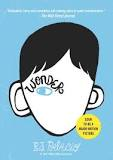“Wonder” by R.J. Palacio
Palacio, R.J.. Wonder. New York: Knopf, 2012.
Lexile: 790
Summary: This is a story about a ten year old named Auggie (August) who lives in NYC and goes to school for the first time since he’s been homeschooled his whole life. He has a facial deformity that prevented him from going to school. His deformity makes it difficult for him to make friends and his story is one that makes readers think, do onto others as you would want done to yourself.
Book Selling Tool: Infographic
Activity: I would use this text with an ELA 5th grade classes.
Students will read this book and identify two reoccurring themes. They will provide text evidence to support their claims. They will then create a storyboard with dialogue from the text to depict each theme as represented in the text. Then students will connect their chosen theme to real life, either imagined or historical, and produce their responses in the form of an online storyboard. (They need one theme to go along with ONE real life example of choice- this gives them application of the theme and real world examples through student choice of response) Some examples of themes would be:
-
Courage
-
Believe in yourself.
-
You are stronger than you think.
-
Family is important.
-
Don’t judge a book by its cover
Standards:
Common Core: Key Idea and Details
Determine a theme of a story, drama, or poem from details in the text, including how characters in a story or drama respond to challenges or how the speaker in a poem reflects upon a topic; summarize the text.
AASL:
2.1.4 Use technology and other information tools to analyze and organize information.
4.1.2 Read widely and fluently to make connections with self, the world, and previous reading. 4.1.3 Respond to literature
Information Literacy:
5.6 Uses various note taking strategies (e.g., outlining, underlining, bulleted lists, highlighting, graphic organizers).
Learning Outcomes: Students will determine themes read throughout the story and be able to use evidence/moments from the story to support their themes. They will also apply real world context be providing a historical/personal example of that theme to create a Storyboard.
Learning Objectives
Students will identify 2 or more themes presented in the story, Wonder, and give evidence to support their answers. (Cognitive)
Students will create a Storyboard that includes a theme that has : dialogue from the story (one more more examples from the book) and one other historical/real world example to go along with the theme. (Psychomotor, Cognitive)
Assessments
Student Graphic Organizers with 2 or more themes identified.
Student created Storyboards
Palacio, R.J.. Wonder. New York: Knopf, 2012.
Lexile: 790
Summary: This is a story about a ten year old named Auggie (August) who lives in NYC and goes to school for the first time since he’s been homeschooled his whole life. He has a facial deformity that prevented him from going to school. His deformity makes it difficult for him to make friends and his story is one that makes readers think, do onto others as you would want done to yourself.
Book Selling Tool: Infographic
Activity: I would use this text with an ELA 5th grade classes.
Students will read this book and identify two reoccurring themes. They will provide text evidence to support their claims. They will then create a storyboard with dialogue from the text to depict each theme as represented in the text. Then students will connect their chosen theme to real life, either imagined or historical, and produce their responses in the form of an online storyboard. (They need one theme to go along with ONE real life example of choice- this gives them application of the theme and real world examples through student choice of response) Some examples of themes would be:
Courage
Believe in yourself.
You are stronger than you think.
Family is important.
Don’t judge a book by its cover
Standards:
Common Core: Key Idea and Details
Determine a theme of a story, drama, or poem from details in the text, including how characters in a story or drama respond to challenges or how the speaker in a poem reflects upon a topic; summarize the text.
AASL:
2.1.4 Use technology and other information tools to analyze and organize information.
4.1.2 Read widely and fluently to make connections with self, the world, and previous reading. 4.1.3 Respond to literature
Information Literacy:
5.6 Uses various note taking strategies (e.g., outlining, underlining, bulleted lists, highlighting, graphic organizers).
Learning Outcomes: Students will determine themes read throughout the story and be able to use evidence/moments from the story to support their themes. They will also apply real world context be providing a historical/personal example of that theme to create a Storyboard.
Learning Objectives
Students will identify 2 or more themes presented in the story, Wonder, and give evidence to support their answers. (Cognitive)
Students will create a Storyboard that includes a theme that has : dialogue from the story (one more more examples from the book) and one other historical/real world example to go along with the theme. (Psychomotor, Cognitive)
Assessments
Student Graphic Organizers with 2 or more themes identified.
Student created Storyboards
No comments:
Post a Comment